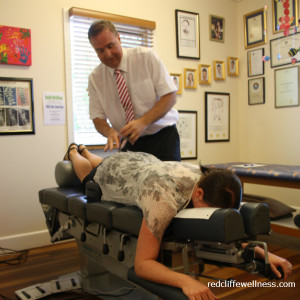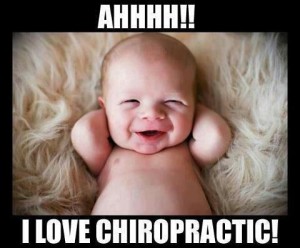“A chiropractor is a registered health practitioner who treats the musculoskeletal system (muscles, ligaments, bone and joints). Chiropractic is used as an alternative to, or to complement, conventional medicine. This article explains what chiropractors do, and includes questions you might ask.
What conditions do chiropractors treat?
Chiropractors diagnose, treat and prevent mechanical disorders of the musculoskeletal system and the effects of these disorders on the function of the nervous system and general health.
Chiropractors treat a range of musculoskeletal conditions, such as back pain, neck pain and headache.
Spinal manipulation is the main treatment used by chiropractors. It is a therapy that involves using the hands to move a joint beyond its usual range of motion. Manual pressure is applied to the spine using different techniques, and some movements may give an audible crack or pop.
Some chiropractors also claim to treat non-musculoskeletal problems, such as ear infections, asthma, allergies, colic in babies and bedwetting. Some also offer advice on childhood immunisation. There is no evidence for the effectiveness of chiropractic in treating these conditions.
Chiropractors do not have the necessary expertise to advise on childhood immunisation. Your medical doctor is the appropriate health professional to discuss the benefits and risks of immunisation for children.
Are chiropractic treatments effective?
Back pain
Spinal manipulation is probably just as effective as, but no more effective than, conventional medical therapy for acute low back pain.
In addition, spinal manipulation has been shown to give minor short-term improvements in pain and function in people with chronic low back pain.
Spinal manipulation is one of several options that include exercise, massage and physical therapy that can provide some relief to low-back pain.
Neck pain
Before recommending a treatment for neck pain, your medical doctor should exclude serious underlying problems.
These problems may include damage to a bone or ligament from significant trauma, infection, cancer, or nerve compression. Spinal manipulation is neither safe nor effective for these serious conditions.
There may be other reasons why spinal manipulation is not appropriate for your neck pain.
A common cause of neck pain is torticollis (twisted neck). Physical therapies such as gentle mobilisation may provide effective relief.
Headache
If you have chronic headaches or migraines your medical doctor should be your first contact. Your doctor may recommend treatments such as rest or pain relief medicines, as well as considering medicines to reduce the frequency of the headaches or migraines.
There is evidence that chiropractic treatments can be as effective as medicines for tension headaches and migraines.
The American Heart Association and American Stroke Association warns of the potential for serious complications following spinal neck manipulation, including stroke, but the evidence for this remains inconclusive.
Non-musculoskeletal conditions
There is no evidence that spinal manipulation can effectively prevent non-musculoskeletal conditions.
Are chiropractic treatments safe?
Spinal manipulation is usually safe, although it can be associated with minor problems and, rarely, very serious side effects.
Minor short-lived complaints following spinal manipulation are common. About half of people who have seen a chiropractor say they felt dizzy, light-headed or numb afterwards, or had a headache, or had more pain or stiffness.
What you can expect during a chiropractic session
The chiropractor is likely to discuss your current health problem, along with your overall medical history. They may perform an examination and you might be offered spinal manipulation.
Should children have chiropractic treatment?
Parents typically seek chiropractic care for their children for musculoskeletal disorders. Chiropractors may provide treatments to children including:
- advice including dietary, ergonomic, and exercise advice
- counselling
- manual therapies such as massage
- manipulation (however, experts are concerned about the risks for babies and children of having spinal manipulation)
Experts agree that there are risks to children including risks from manual therapy, or indirectly from delayed diagnosis or misdiagnosis.
The Chiropractic Board of Australia says there is a lack of quality evidence on the chiropractic care of children. The Chiropractic Board expects chiropractors treating children to:
- discuss their proposed management plan with the child, parent, or guardian
- inform the child, parent, or guardian about the quality of evidence and explain the basis for the proposed treatment
- provide information about the risks and benefits of the proposed treatment and the risks of receiving no treatment
- ensure they have the specific skills and expertise before treating children
- modify all care and treatment to suit the age, presentation and development of the patient
Some chiropractors say they can treat ear infections, asthma, allergies, autism, bed-wetting and colic in babies. There is no evidence these claims are true.
What should I ask my chiropractor?
Before or during your appointment with a chiropractor, you may like to ask some of the following questions:
- Why do you recommend this treatment? What is the evidence for its effectiveness?
- What are the risks involved in this treatment?
- What are the possible side effects?
- If you treat 100 people with this problem, how many experience side effects?
- Should I discuss this treatment plan with my doctor first?
It would also be important to let your chiropractor know of any medical condition that may affect your treatment or put you at higher risk of side effects from spinal manipulation.
You might be at a higher than usual risk of having complications if you have:
- a medical condition that affects your bones and joints, such as osteoporosis, arthritis or hypermobility (extra stretchy joints)
- medicines and conditions that increase your risk of bleeding
- medicines and conditions that weaken the skin
Where do I find a registered chiropractor?
In Australia, chiropractors are registered through the Australian Health Practitioner Regulation Agency (AHPRA). The AHPRA website has a searchable database which you can use to check the registration status of your chiropractor.


